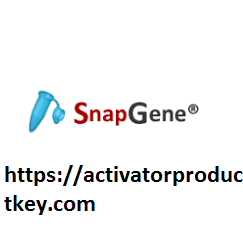
“In addition to sharing very similar goals, there is also significant potential for cooperation and integration with other products in our portfolio of companies, including Tetrascience, Labguru, BioRAFT and Figshare.” “Our mission at Digital Science is to bring innovative tools to researchers that allow them to spend more time where they add most value, so Transcriptic is a perfect fit for us,” said Daniel Hook, CEO of Digital Science.
#Snapgene ucsf free
“DCVC has doubled down on Transcriptic because they are uniting these technologies to free life sciences researchers from the heavy tax of assembly-line lab processes, enabling them to accelerate life-saving breakthroughs.” “At Data Collective (DCVC), we are investing at the intersection of AI, robotics, and hyper-scale data and compute to transform global industries,” said Matt Ocko, Managing Partner. Our goal is to make life science research cheaper, faster, and more accessible, and today’s investment will enable us to deliver further innovations to make that a reality.”

“The Transcriptic platform has freed researchers from many hours of painstaking, error-prone work and enabled them to focus where their time is most valuable. "Since we founded Transcriptic in 2012, we have seen a significant change in how the industry thinks about lab work," said Max Hodak, CEO of Transcriptic. The company, which developed the open source Autoprotocol language for codifying lab protocols, helps researchers take their research to an automated, highly-scalable and safe environment in which machine learning techniques can be used to to speed up discovery.

In today’s increasingly digital research environment, where consistent data is essential and reproducibility of results a necessity, Transcriptic is redefining how research is delivered. The new funds will allow the company to grow its team to accommodate further growth, extend the capabilities of its innovative platform, and deliver on its vision of using its automated platform to dramatically increase research productivity. Since the company launched in 2012, the company has executed experiments for individual researchers, institutions and large pharmaceutical businesses. Transcriptic will utilize the new capital to drive the company’s product, team and expansion plans. Existing investors, including AME Cloud Ventures, and others also contributed to the round. The new funding was led by Data Collective, along with new investors Digital Science and WuXi AppTec.
#Snapgene ucsf series
17, 2016 – Transcriptic Inc., a robotic cloud laboratory for life sciences, today announced the closing of a $13.4 million Series A-1 investment. The new CSDaV-based expression vectors may provide an alternative platform for use in molecular farming, either for production of heterologous proteins or as scaffold for heterologous protein display.New Capabilities Will Significantly Increase Impact Therefore, individual co-expression of GFP-CPp21 and CPp21 in the same plant cells leads to the production of chimeric virus-like particles (VLPs), while GFP-CPp21 fusion protein itself is not able to self-assemble into VLPs. We show though that the incorporation of GFP-CPp21 fusion protein into virions occurs solely due to its interaction with free/non-fused CPp21, independent of other viral proteins. Cryo-electron microscopy analysis from this work revealed the structures of the wild-type and the GFP-recombinant CSDaV virions, but it was not able to reveal where exactly the GFP is displayed in the chimeric virions. However, GFP-recombinant CSDaV virions do not appear uniformly assembled, but more likely as mosaic particles. We show that higher amounts of GFP can be produced from a coat protein (CP)-independent CSDaV-based vector, compared to levels of GFP expressed from a widely used non-replicative vector (pEAQ series) or GFP can be produced in fusion with the major CSDaV CP (CPp21) to be incorporated into chimeric virions. These vectors were generated to express the reporter green fluorescent protein (GFP) in Nicotiana benthamiana leaves by taking advantage of the expression strategies used by CSDaV to produce its structural proteins. In this work, we generated new replicative virus expression vectors based on a previously constructed citrus sudden death-associated virus (CSDaV) infectious cDNA clone. Advances in the development of virus-based expression systems have been possible due to generation of many virus infectious clones, especially those derived from plant viruses, which have the capability for rapid and high-level transient expression of proteins in plant cells, a robust and low-cost bioreactor.

The more we understand the strategies used by viruses for protein expression, the more possibilities we have to exploit viruses as expression vectors for heterologous protein production.


 0 kommentar(er)
0 kommentar(er)
